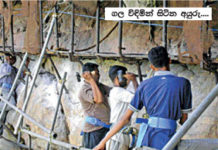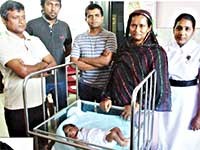by Randima Attygalle
COVID-19 pandemic has changed the whole economic landscape at national and international level, and agriculture is no exception. Economic recession is inevitable and we have already got red alerts about the future. Non-essential imports have been banned or restricted. Many avenues available for export earnings have closed affecting local industries and reducing foreign exchange earnings.
“We anticipate serious negative impacts on global and national economy in months to come. But, our decisions and actions should be based on a ‘no regret’ principle. All proposed action should work well under any condition and contribute to the agricultural economy. It is important to note that agriculture alone cannot meet the food security of a nation. Our efforts will be to maximize the contribution of agriculture sector to achieve food security. There is a market space created. We have a huge opportunity,” reflects Prof. Buddhi Marambe from the Department of Crop Science, Faculty of Agriculture, University of Peradeniya.
Speaking to the Sunday Island, Prof. Marambe who is also the Chairman of the National Invasive Species Specialist Group (NISSG) of the Ministry of Environment and the President of Weed Science Society of Sri Lanka (WSSSL) elucidates on the way forward in turning this dark hour into a window of abundant hope for the Sri Lankan agriculture sector. Following are the excerpts:
Q: Can you throw light on where our agriculture sector was placed as an industry in the Pre-COVID 19 phase
A: Sri Lankan agriculture sector has evolved over the past decades with significant achievements in rice, maize and poultry sectors. However, the sector is plagued with persistent problems in other food crops, livestock, plantation, and export agricultural crop sectors.
Prof. Buddhi Marambe
The relative contribution of agriculture to the Gross Domestic Production (GDP) has declined over the years, from 8.5% in 2010 to 7% in 2018. The growth rate of agriculture sector in 2016/2017
(-0.4% due to extreme drought in 2016), bounced back in 2017/2018 to 4.8% showing the highest compared to Industry (0.9%) and services (4.7%). In 2018, agricultural exports accounted for 21.7% of total national exports.
Labour participation declined from 32.7% in 2010 to 25.5% in 2018. The labour productivity increased marginally from 0.29 (2015) to 0.33 (2018) in millions of rupees per person per year, with the gradual adaptation of new technology and mechanization.
Before Covid-19, Sri Lanka was making a continuous effort to:
· enhance crop and animal productivity to meet the increasing demand and changing lifestyles
· cut down the heavy post-harvest losses in perishables
· prioritize crops/animals to be considered for sustenance in food and nutrition security
· meet labour shortages at crucial times (e.g. planting and harvesting of crops)
· infuse novel agricultural technologies into agriculture
· enact a Plant Variety Protection (PVP) Act to attract many investors
· ensure timely availability of many important agricultural inputs
· enhance foreign exchange earnings through value added agricultural exports
· come to terms with labour wages in the plantation sector
· face stiff competition from competitive agricultural export
· overcome inefficiencies in the food supply chain, including assuring food safety and
· establish strong evidence-based overarching policies to cover the entire agriculture sector.
Q: What are the main challenges our agriculture sector faces today, especially in the light of the policies, human resources, infrastructure, quality assurance and quantity, food safety, storage, chemical use, market space, farmers interests, traders play, attitudes and post-harvest loss etc.?
A: In the backdrop of the present crisis, the persistent problems the sector had been facing over the years have got intensified. Vegetable and fruit farmers are facing a severe blow in terms of harvesting (due to non-availability of labour) and marketing (due to the failure in distribution networks, closure of Dedicated Economic Centers (DECs), restriction in inter-district movements, etc.) Animal production sector (e.g. milk, meat and eggs) is also faced with severe limitations in product marketing. All in all, our distribution system for dry and fresh agricultural products has failed to cope up with this crisis situation. This has further enhanced postharvest losses. We have moved from bad to worse.
The paddy, maize and part of vegetable harvesting were fortunately done before declaring a pandemic. The paddy harvested in Maha season (2019/2020) would be adequate for the next nine months, however, it will depend on any reduction in wheat consumption. The cultivation in immediate Yala season of 2020 will cushion this additional impact to a greater extent. The Yala cultivating season will not feel much pressure as majority of the cultivation needs are already met. For example, inputs (seeds and pesticides) have been imported or produced by the state and private sector, ships carrying the much required fertilizer have started reaching our ports. But, some efforts are needed to meet the demand gap for maize in animal feed industry (poultry and dairy) with India closing its borders. Keeping the animal production sector (livestock, poultry and fisheries) progressing with the required inputs will be challenging.
The government has started intervening heavily in the food distribution. Rice milling made an essential service, and maximum retail prices imposed for many essential goods. Home delivery and online purchase systems have flourished and become household words, though there are still some hiccups. Main supermarkets have hit the ceiling in their delivery capacity, including available manpower, but the state sector (CWE) has established an effective private-public-partnership (PPP) for home delivery of groceries. This is a very good move. The District/Divisional Secretariats and the Civil Defense Force have started procuring vegetables and distributing them among the community, benefitting the producer and consumer. The challenge is to introduce better and sustaining distribution systems through PPP, without burdening state entities that have different mandated functions, and not geared for such practices with adequate machinery (e.g. transport) or trained staff. The state sector is not a substitute for the private sector.
The next Maha (starting from September 2020) is the major season that we all should focus from now. For an enhanced productivity drive in Maha (2020/2021) for food and fodder, we need adequate quantities of high quality seeds and planting materials, and essential agriculture inputs. For example, the largest extents of paddy and maize are cultivated during Maha season. Seed paddy production is 100% in-country activity; however, as at present, the majority of maize and many other fruits and vegetable production are dependent on imported hybrid seeds. Considering potential restriction in seed imports, the challenge is to produce adequate planting materials of high yielding varieties for priority crops, starting from this Yala season.
Issues of food safety and quality assurance of the products home delivered even by few reputed entities, have been raised. The organized private sector needs to be more organized in these activities. Same issues are raised with the operations in DECs, which now depend on the regulations imposed by health authorities. The challenge is to have effective communication networks between producers and collection centers/collectors and ensure safe, nutritious and high quality food reach the consumers, and minimize post-harvest losses.
We have failed miserably in the past to have well-defined policies covering all aspects of agriculture development in the country. The recent efforts made by the Department of National Planning of Sri Lanka to develop an overarching agriculture policy (OAP) covering food crops, plantation crops, export agricultural crops, livestock and poultry, fisheries, irrigations, agrarian development, and environment should materialize soon. The OAP sets up a long term vision and should be used to develop sectoral policies in all sub sectors in agriculture that could benefit the agricultural sector during the post- COVID-19 era.
Q: What are your thoughts on the home garden programme launched by the government with the objective of achieving food security in the country?
A: The programme will no doubt assist in keeping people engaged during the period of work from home and enhance their mental and physical levels of satisfaction. Further, everyone will start developing a liking towards agriculture. However, its contribution to national food security is marginal as food security goes far beyond boundaries of a HG. Lots of money, energy and precious seed material have been spent on this. We have to change this ‘small is beautiful’ mindset when it comes to a massive operation like agriculture. We are looking at national level food security while ensuring farmer profitability. We never learn from past mistakes. Shortage of locally produced seeds will impact commercial vegetable growers and vegetable markets may even crash when HG production is available in three or four months. The challenge is to gear farming community to face this situation and advice policy makers not to opt for such short sighted policy actions.
Q: How do we go for a revolutionary change in the industry attracting investors both foreign and local, having new interventions for data driven decision-making, new technology, research & development, new markets and mitigating post-harvest loss?
A: The supply chain operations during COVID-19 period must have added more losses to already known post-harvest losses of perishables (30-40%). We need to reduce food miles by using most direct transportation. The railway system should be used where possible, with dedicated waggons to transport food. Supply chains should be shortened to support quick access of food to consumers. Further, provision of small-scale solar-powered cold storage for farmer groups and refrigerated transport systems to maintain quality of fresh products, and re-introducing traditional and novel food preservations systems are imperative. A well-coordinated and quality-assured home-delivery system, with lessons learned from the mistakes during this period is a must.
We have seen revolutionary changes in marketing during this crisis period. Tea auction went online after 126 years while coconut auction was online after 26 years. Our export agriculture sector should move towards this end with more ICT involvement, inviting more buyers and exploiting new market destinations, marketing/E-commerce with virtual platforms coupled with cyber-extension services are a need. All these will help reduce post-harvest losses with higher gains for all players in the supply chain.
More infusion of new technology and making technology affordable to famers is the key to success. Sri Lankan farmers have shown lots of promise in adopting technology. The front and the rear end of rice cultivation are heavily mechanized. Use of protected agriculture, micro-irrigations and fertigation systems have become popular among those who have the investment capacity with a high-end product development. However, the heavy custom tariffs have discouraged people in using such technologies and their further expansion owing to less affordability. Hence, the government should ensure novel technological packages and tools, especially those imported, made tax free at least for a period of six months to make agriculture more productive under variable climates. Such provisions will enhance much needed investments in agriculture, and support tech-savvy farming community.
Production of good quality seeds and planting material for the next Maha season (2020/2021) is crucial. All state and university farms should be directed to produce certified seeds and planting materials for selected priority crops. Seed industry should be kept alerted on the forthcoming seed requirement. Further, The Department of Agriculture has launched a successful PPP model to multiply hybrid chilli (MICH) seeds with several private sector entities. Our own maize hybrids (MI Maize Hybrid 01 and MI Maize Hybrid 02) have been produced but require popularization and adequate seed production for cultivation. This also requires active involvement of the private sector, which will further support the animal feed industry.
Precision agriculture is the future. We need to open up for the next generation of technologies available. Fertilizer technologies (production and application) should change to produce more from less inputs. Pesticide application technologies should be target-oriented and not indiscriminately used. New nutrient supplement mechanisms researched in Sri Lanka, such as using nanofertilizers, slow-release fertilizers, bio-fertilizer, bio-pesticides, coupled with soil conditioning via composting need, use of novel application technologies such as drones to be popularized. The Good Agriculture Practices (GAP) certification programmes must be aggressively promoted to get more practitioners on board. Groups of fresh agriculture graduates will be a good asset to be utilized in such activities.
Q: What is the role of the private sector in this process?
A: The private sector needs to be further proactive. Bitter lessons are learned. Capacity expansion, more coordination and meeting growing demand for on-line orders, etc. require due consideration by the private sector. Private sector also should be more genuine and responsible being in the food supply chain. It is important to note that the government machinery in local governments, having infrastructure and manpower to be involved in food distribution, has not been fully utilized yet. These entities should strongly collaborate with the private sector. User-friendly virtual marketing platforms (where producers and buyers meet) for instance, will help in supporting such distribution systems.
Q: What are the main strengths of the Sri Lankan agriculture sector in attracting investments?
A: Being a tropical island, the country is blessed with an agro-climate covering many scenarios favourable for different crops. This is an unparalleled strength. In this regard, proper land use planning is imperative. We have to grow what we can grow best. Sri Lanka has prioritized 16 crops for production and productivity enhancement during post-COVID-19 era. This is a large number I believe. We need to re-prioritize within this group to decide on the investment of limited finances and also invite potential investors.
We are also a country blessed with a large contingency of well-trained scientists, professionals, and high-capacity research facilities – at Department of Agriculture, Department of Animal Production and Health, Faculties of Agriculture in Universities, Tea, Rubber, Coconut and Sugarcane Research Institutes, other state entities including SLINTEC and NIFS, and private sector organizations. They have contributed immensely to the development of the agriculture sector of the country together with the practitioners/farming community by development of varieties/breeds, production technology packages, etc. This is the enormous security that we have to invite and attract investments to do more research and development, and come up with more innovations to support the agriculture sector. What is required is to allow them to make decisions on agriculture development of the country, without undue political interference. Every individual can plant a crop, but everyone cannot do agriculture. Leave it to the professionals and experienced practitioners.
Q: What are the challenges we have today to compete in the world market?
A: The global economy has shown signs of a free fall. International trade and tourism have been drastically affected. Sri Lanka’s export earnings are dipping due to this economic recession. Countries are likely to be selective in their imports. Sri Lanka need to be aggressive in its export promotion to gain much needed foreign exchange, and continue negotiations with new market destinations through the our foreign mission, including the organically-certified products. Having quality-certified products, including nutritional qualities and medicinal properties of food products exported from Sri Lanka will create more export markets in the post-COVID-19 era.
Some export opportunities for Sri Lanka, however, still prevail and we need to exploit them at most without delay. For example, the hotel industry in different locations such as the Maldives has been heavily affected for fresh food imports due to closure of borders in India. We have been a continued supplier of fresh agricultural products to the Maldives. However, a bigger market space has now been created for us to capture and gain the maximum benefit. Further, the ability of ‘theaflavin-3-3-digallate’ (TF3) found in black tea to potentially inhibit SARS-Cov (the virus which was identified in 2003) has created an interest and demand for black tea in the global market. A market place has been created and it is up to us to make use of this in brand promotion.
Q: How can Sri Lanka position in the global map as a country with great agri- potential in the post COVID- world?
A: Combating COVID-19 successfully stays in our prayers. Would this happen early, it will open up a massive window of opportunity for Sri Lanka’s agriculture sector to prosper. Assuming such in the near future, a simple phrase “product from COVID-19-free Sri Lanka” would make it the most sought after in the global market. However, we all should understand that recovery from the impact of COVID-19 is not returning to what was there during pre-COVID-19 to start with the same set of persistent problems. We should take a great leap forward and aim for it.
Q: Finally how important do you think it is to have an optimistic ‘collective national attitude’ towards our rich agri history which can be capitalized in the global market?
Q: We Sri Lankans are proud of our hydrological civilization and agricultural history, which we need to trade mark in the agricultural products. Ceylon Tea and Ceylon Cinnamon logos have gained ground in the world market with the highlights of the rich history related to the products. Similarly, we should re-visit the marketing strategies of Sri Lankan products released to the global market, using the rich agricultural history of the country. The efforts of the government missions, Export Development Board, and exporters alone would not suffice in this exercise to regain and further expand our export markets. This will be a shared responsibility of every Sri Lankan and Sri Lankan industry. We have to have our mind-setting done to collectively lift Sri Lanka from this worst economic crisis ever
– The Island





















